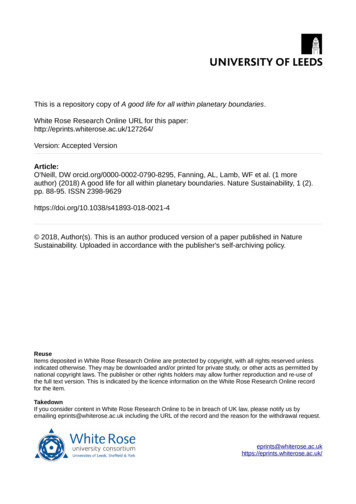
Transcription
This is a repository copy of A good life for all within planetary boundaries.White Rose Research Online URL for this n: Accepted VersionArticle:O'Neill, DW orcid.org/0000-0002-0790-8295, Fanning, AL, Lamb, WF et al. (1 moreauthor) (2018) A good life for all within planetary boundaries. Nature Sustainability, 1 (2).pp. 88-95. ISSN 2398-9629https://doi.org/10.1038/s41893-018-0021-4 2018, Author(s). This is an author produced version of a paper published in NatureSustainability. Uploaded in accordance with the publisher's self-archiving policy.ReuseItems deposited in White Rose Research Online are protected by copyright, with all rights reserved unlessindicated otherwise. They may be downloaded and/or printed for private study, or other acts as permitted bynational copyright laws. The publisher or other rights holders may allow further reproduction and re-use ofthe full text version. This is indicated by the licence information on the White Rose Research Online recordfor the item.TakedownIf you consider content in White Rose Research Online to be in breach of UK law, please notify us byemailing eprints@whiterose.ac.uk including the URL of the record and the reason for the withdrawal terose.ac.uk/
A good life for all within planetary boundariesDaniel W. O’Neill1*, Andrew L. Fanning1, William F. Lamb2, and Julia K. Steinberger11Sustainability Research Institute, School of Earth and Environment, University of Leeds,Leeds, LS2 9JT, UK2Mercator Research Institute on Global Commons and Climate Change (MCC), TorgauerStrasse 1215, 10829 Berlin, Germany*e-mail: d.oneill@leeds.ac.ukArticle accepted for publication in Nature SustainabilityJanuary 2018
A good life for all within planetary boundariesDaniel W. O’Neill, Andrew L. Fanning, William F. Lamb, and Julia K. SteinbergerHumanity faces the challenge of how to achieve a high quality of life for over seven billion peoplewithout destabilising critical planetary processes. Using indicators designed to measure a “safe andjust” development space, we quantify the resource use associated with meeting basic humanneeds, and compare this to downscaled planetary boundaries for close to 150 nations. We find nocountry meets basic needs for its citizens at a globally sustainable level of resource use. Physicalneeds such as nutrition, sanitation, access to electricity, and the elimination of extreme povertycould likely be met for all people without transgressing planetary boundaries. However, theuniversal achievement of more qualitative goals (e.g. high life satisfaction) would require a level ofresource use that is 2–6 times the sustainable level, based on current relationships. Strategies toimprove physical and social provisioning systems, with a focus on sufficiency and equity, have thepotential to move nations towards sustainability, but the challenge remains substantial.This article addresses a key question in sustainability science: What level of biophysical resource useis associated with meeting people’s basic needs, and can this level of resource use be extended to allpeople without exceeding critical planetary boundaries? To answer this question, we analyse therelationships between seven indicators of national environmental pressure (relative to biophysicalboundaries) and eleven indicators of social outcomes (relative to sufficiency thresholds) for close to150 countries. Our study represents the first attempt to measure national performance using a“safe and just space” framework1,2 for a large number of countries, and provides important findingson the relationships between resource use and human well-being.A Safe and Just SpaceThere have been two recent, complementary advances in defining biophysical processes, pressures,and boundaries at the planetary scale. The first is the planetary boundaries framework, whichidentifies nine boundaries related to critical Earth-system processes 3. The boundaries jointly define a“safe operating space”, within which it is argued the relatively stable conditions of the Holocene maybe maintained4. Of the seven measured planetary boundaries, four are currently transgressed(biosphere integrity, climate change, biogeochemical flows, and land-system change) 3.The second advance is the estimation of environmental “footprint” indicators for multiple types ofbiophysical resource flows. Footprint indicators associate specific environmental pressures (e.g. CO 2emissions, material extraction, freshwater appropriation) with the consumption of goods andservices5. This approach assigns responsibility for embodied resource use to final consumers, andincludes the effects of international trade.We combine these two approaches to measure sustainability at the national scale, by comparingnational consumption-based environmental footprints to “downscaled” planetary boundaries 6. Thenascent literature proposes a number of different ways that planetary boundaries could theoreticallybe downscaled to national equivalents 7, taking into account factors such as geography, internationaltrade, and equity8. Some studies apply a top–down approach that distributes shares of eachplanetary boundary to countries based on an allocation formula 9-11, while others apply a bottom–upapproach that associates local or regional environmental limits with each planetary boundary 12,13.Within our analysis we apply a top–down approach that distributes shares of each planetaryboundary among nations based on current population (a per capita biophysical boundary approach).While the environmental justice literature emphasises the need for differentiated responsibilities inpractice14, a per capita approach allows us to explore what quality of life could be universallyachieved if resources were distributed equally. It is an important question to address given that it isoften claimed that all people could live well if only the rich consumed less, so that the poor could–1–
consume more2,15. We acknowledge that an annual per capita boundary may not be an appropriateway to manage resources that are geographically and temporally bounded (e.g. freshwater use,where river-basin geography and a monthly timescale may be more appropriate in practice 16).Moreover, a deeper understanding of equity may require some notion of shared responsibilitybetween producers and consumers 17.In this article we adopt a human needs-based approach to defining and measuring social outcomes,drawing on the work of Max-Neef 18 and Doyal and Gough19. Human needs theory argues that thereare a finite number of basic human needs that are universal, satiable, and non-substitutable. “Needsatisfiers” can vary between individuals and cultures, but arguably have certain universalcharacteristics that may be measured empirically 20.The theory of human needs developed by the above authors underpins the “safe and just space”(SJS) framework proposed by Kate Raworth 1, and described in her recent book Doughnut Economics2.The framework combines the concept of planetary boundaries with the complementary concept ofsocial boundaries. It visualises sustainability in terms of a doughnut-shaped space where resourceuse is high enough to meet people’s basic needs (the inner boundary), but not so high as totransgress planetary boundaries (the outer boundary).The SJS framework includes 11 social objectives, which were selected by Raworth based on acomprehensive text analysis of government submissions to the Rio 20 conference. The objectivesreflect the main social goals mentioned in the majority of submissions, and thus align well withcontemporary policy, including the social objectives in the UN Sustainable Development Goals(SDGs)21. The SJS framework also has important precedents in the ecological economics literature,namely the objectives of sustainable scale, fair distribution, and efficient allocation 22.We argue that the SJS framework operationalises the concept of “strong sustainability” 23. It requiresthat stocks of critical natural capital be maintained (via the planetary boundaries requirement), whileat the same time requiring that stocks of critical human and social capital also be maintained (thebasic needs requirement). What the SJS framework lacks, however, is a conceptualisation of howresource use and social outcomes are linked. Understanding and quantifying this link is critical fordetermining whether it is actually possible for countries to operate within the “safe and just space”.Analytic FrameworkOur analytic framework (Fig. 1) is based on the Ends–Means Spectrum 24,25, which we have previouslyused for measuring strong sustainability 26,27. Importantly, the framework does not imply a one-waycausal link between resource use and social outcomes; instead, it is intended to show that socialoutcomes are dependent on healthy, functioning ecosystems and the resources that they provide.Feedback loops run both ways, and society may mitigate or adapt to the transgression of planetaryboundaries, thus changing the underlying system structure or its parameters 28.Here we extend the framework by (i) using a basic needs approach to conceptualise social outcomeswithin nations (separating between need satisfiers and human well-being), and (ii) representing thelink between resource use and social outcomes in terms of provisioning systems. For our purposes,provisioning systems comprise both physical and social systems; the former include networks ofphysical infrastructure, technologies, and their efficiencies 29, while the latter encompass governmentinstitutions, communities, and markets 30. Provisioning systems mediate the relationship betweenbiophysical resource use and social outcomes. For example, different forms of transportationinfrastructure (railways versus highways) generate similar social outcomes at very different levels ofresource use. Within our analysis we do not attempt to characterise different types of provisioningsystems or their effects on the relationship between resource use and social outcomes—this remainsa complex challenge for Earth-system researchers going forward 31. However, we do quantify theresource use associated with meeting basic needs in different countries, thus giving an indication ofcurrent possibilities.–2–
Although existing analyses have quantified the links between social performance and biophysicalindicators such as energy use 32, greenhouse gas emissions33, and ecological footprint34, theseanalyses have not considered the implications of planetary boundaries on social outcomes. Twostudies have considered biophysical boundaries and social outcomes using the SJS framework forspecific countries and sub-regions (South Africa 12 and two regions of China 13), while a third study hasapplied the framework to five cities 35. However, these studies have been limited in theirgeographical scope, and they have not quantified the links between the biophysical boundaries andsocial thresholds, which a number of authors have argued need to be better understood 8,11. In short,existing studies have either quantified the limits (but not the links) or the links (but not the limits).This article addresses this gap in the literature by investigating what level of biophysical resource useis associated with meeting people’s basic needs, and whether this level of resource use can beextended to all people without exceeding critical planetary boundaries.Biophysical Boundaries and Social ThresholdsWe downscale four planetary boundaries (climate change, land-system change, freshwater use, andbiogeochemical flows) to per capita equivalents, and compare these to footprint indicators at thenational scale. In addition, we include two separate footprint indicators (ecological footprint andmaterial footprint) and compare these to their suggested maximum sustainable levels 5. Theecological footprint and material footprint are not part of the planetary boundaries framework, andpartially overlap with the climate change indicator (they both include fossil energy as a component).However, as they are widely-reported measures of environmental pressure, we include them forcomparison. Since the planetary boundary for biogeochemical flows is represented by two separateindicators (nitrogen and phosphorus), seven biophysical indicators are considered in total (Table 1).All seven indicators are consumption-based measures that account for international trade.Due to the difficulty in translating the planetary boundary for atmospheric CO 2 concentration into ameaningful per capita boundary, we base our calculations on the goal of limiting global warming to2 C, as emphasised in the Paris Agreement. As a measure of land-system change, we use a rathernovel indicator, namely “embodied human appropriation of net primary production” (eHANPP) 36,which has been proposed as a measurable planetary boundary 37. eHANPP measures the amount ofbiomass harvested through agriculture and forestry, as well as biomass that is killed during harvestbut not used, and biomass that is lost due to land use change. See Supplementary Information for afull discussion of the individual biophysical indicators.To assess social outcomes, we use a set of eleven social indicators that are common to studiesfollowing the SJS framework 1,12,13 and the social objectives contained in the SDGs 21. Within ourframework, these indicators include nine need satisfiers (nutrition, sanitation, income, access toenergy, education, social support, equality, democratic quality, and employment) and two measuresof human well-being (self-reported life satisfaction and healthy life expectancy). For each of theseindicators we identify a threshold value consistent with a “good life” for a nation’s citizens (Table 2).Although the choice of the social thresholds is undoubtedly subjective, we believe each constitutes areasonable assessment of a level of performance consistent with meeting basic needs. SeeSupplementary Information for a full discussion of the individual social indicators.We find that the majority of the countries analysed are using resources at levels above the per capitabiophysical boundaries (Table 1). The most difficult biophysical boundary to meet is climate change:only 34% of countries are within the per capita boundary for this indicator. The number of countriesthat are within the per capita boundaries for phosphorus, nitrogen, eHANPP, ecological footprint,and material footprint is remarkably similar overall, with roughly 45% of countries within theboundary for each of these indicators. The picture is substantially better for the blue waterboundary, which over 80% of countries are currently within, reflecting the fact that this boundary isnot transgressed at the planetary scale. However, this result says nothing about regional waterscarcity, which may result from intra-annual variability or differences in water availability across river–3–
basins. Overall, 16 countries remain within all seven per capita biophysical boundaries, while thereare 48 countries that transgress six or more of them (Fig. 2).From a social perspective, the results are rather mixed (Table 2). Close to 60% of the countriesanalysed perform well on the social indicators related to meeting physical needs such as nutritionand access to energy, and close to 70% have eliminated poverty below the 1.90 a day line.Countries do not perform as well on the more qualitative goals, however. Only a quarter of thecountries analysed achieve sufficient outcomes on the indicators of life satisfaction and socialsupport, while less than a fifth achieve sufficient outcomes on the indicators of democratic qualityand equality. Only three countries (Austria, Germany, and the Netherlands) achieve all eleven socialthresholds, although an additional seven (mostly European) countries achieve ten of them. Thirtyfive countries fail to achieve more than a single social threshold (Fig. 2).No country performs well on both the biophysical and social indicators. In general, the more socialthresholds a country achieves, the more biophysical boundaries it transgresses (Fig. 2), and viceversa. Many wealthy nations achieve the majority of the social thresholds, but at a level of resourceuse that is far beyond the per capita biophysical boundaries. For example, although the UnitedStates achieves the threshold associated with a good life for nine of the eleven social indicators, ittransgresses the per capita boundary for all seven biophysical indicators (Fig. 3a). In contrast, SriLanka, which does not transgress any of the biophysical boundaries, only achieves sufficientoutcomes on three of the social indicators (Fig. 3b). Vietnam is a possible exception to the pattern,transgressing only one biophysical boundary (CO 2 emissions), but achieving sufficient outcomes onsix social indicators.In general, the more social thresholds associated with need satisfiers that a country achieves, thehigher the level of human well-being, as measured by life satisfaction and healthy life expectancy(see Supplementary Fig. 1). These results provide some evidence in support of the argument thathuman well-being is a function of both the level to which basic needs are met and the extent towhich individuals are satisfied with this level 38,39. Countries with higher levels of life satisfaction andhealthy life expectancy also tend to transgress more biophysical boundaries (Supplementary Fig. 2).Relationship between IndicatorsThe strength of the relationship between biophysical and social indicators varies depending on theindividual indicators considered (see Supplementary Table 3). In general, social performance is mosttightly coupled to CO2 emissions and material footprint, and least tightly coupled to eHANPP. Theweak relationship between eHANPP and the social indicators is consistent with previous workshowing that eHANPP is strongly linked to population density, but not to other socioeconomicfactors40.The social indicators most tightly coupled to resource use are secondary education, sanitation, accessto energy, income, and nutrition. With the exception of education, these are more closely associatedwith meeting physical needs than with achieving more qualitative goals (e.g. social support anddemocratic quality). The social indicator least tightly coupled to resource use is employment.In cases where there is a statistically significant relationship between biophysical and socialindicators, the relationship is always positive (i.e. higher social performance is associated with higherresource use). Moreover, the best-fit curve is generally either linear–logarithmic in form or asaturation curve (Supplementary Table 3). Both shapes suggest diminishing social returns withhigher resource use. The only exception is equality, which increases linearly with resource use.Fig. 4 presents the level of resource use, relative to per capita biophysical boundaries, associatedwith achieving a sufficient level of performance on each social indicator. Two quantities are shown:(a) the median level of resource use of the countries closest to each social threshold, and (b) the–4–
lowest level of resource use (i.e. best performance) achieved by any country that meets the socialthreshold.The largest gap between current performance and the biophysical boundary occurs for CO 2emissions, where the median level of resource use associated with a sufficient score on the socialindicators ranges from about 1.5 times the biophysical boundary for nutrition and sanitation, to oversix times this boundary for education and life satisfaction. That said, the large difference betweenthe median and lowest levels of CO 2 emissions for some of the social thresholds (e.g. education andlife satisfaction) demonstrates that much more carbon-efficient provisioning systems are possible.The median results for phosphorus and nitrogen are very similar to CO 2 emissions, although the levelof resource use associated with sufficient social performance is a bit lower. For material footprintand ecological footprint, the median estimate varies less, from around the biophysical boundary toover three times this level. The least-strict biophysical boundary is blue water use, where a high levelof performance can be achieved on all social indicators without transgressing the planetaryboundary. This result says nothing of local water scarcity issues, however.The social goals with the highest associated resource use, ranging from about two to six times theper capita biophysical boundary, are democratic quality, equality, social support, secondaryeducation, and life satisfaction. These are the more qualitative social goals, and although they areassociated with high resource use, they are in general not tightly coupled to resource use. Incontrast, the social goals that relate more directly to meeting physical needs (i.e. nutrition, income,access to energy, and sanitation) are more tightly coupled to resource use, but have much lowerassociated resource use in general. In fact, our results indicate that a sufficient level of performanceon these four indicators could likely be achieved for all people without significantly exceedingplanetary boundaries. An important exception to the overall pattern is secondary education, whichis both strongly coupled to resource use and associated with high resource use.While the median resource use values give a business-as-usual view, they may be overly pessimisticabout what is possible. The “best performance” values show that some nations are able to achievethe social thresholds at a much lower level of resource use. These results give a sense of thepossibility space for achieving the social thresholds within planetary boundaries, while alsohighlighting the unequal distribution of current resource use among countries. For four of the socialindicators (i.e. education, access to energy, income, and nutrition), there is at least one country thatachieves the threshold associated with a good life without transgressing any of the per capitabiophysical boundaries. There is no single best-performing country, however. In general it is adifferent country that performs well in each biophysical–social indicator pair. For two of the othersocial indicators (i.e. democratic quality and life satisfaction) there is generally no country thatachieves the social threshold within the biophysical boundaries (leaving aside blue water).DiscussionIf all people are to lead a good life within planetary boundaries, then our results suggest thatprovisioning systems must be fundamentally restructured to enable basic needs to be met at a muchlower level of resource use. These findings represent a substantial challenge to current developmenttrajectories. Given that the UN’s “medium variant” prediction is for global population to rise to 9.7billion people by 2050, and 11.2 billion by 2100 41, the challenge will be even greater in future ifefforts are not also made to stabilise global population. It is possible that the doughnut-shapedspace envisaged by Kate Raworth1,2 could be a vanishingly thin ring.Physical needs (i.e. nutrition, sanitation, access to energy, and elimination of poverty below the 1.90 line) could likely be met for seven billion people at a level of resource use that does notsignificantly transgress planetary boundaries. However, if thresholds for the more qualitative goals(i.e. life satisfaction, healthy life expectancy, secondary education, democratic quality, social support,–5–
and equality) are to be universally met then provisioning systems—which mediate the relationshipbetween resource use and social outcomes—must become two to six times more efficient.Based on our findings, two broad strategies may help move nations closer to a safe and just space.The first is to focus on achieving “sufficiency” in resource consumption. For most of the biophysical–social indicator pairs analysed in this study, each additional unit of resource use contributes less tosocial performance, particularly beyond the turning point where the estimated linear–logarithmic orsaturation curves flatten out (Supplementary Table 3). Our results suggest resource use could bereduced significantly in many wealthy countries without affecting social outcomes, while alsoachieving a more equitable distribution among countries. A focus on sufficiency would involverecognising that overconsumption burdens societies with a variety of social and environmentalproblems42, and moving beyond the pursuit of GDP growth to embrace new measures of progress 43.It could also involve the pursuit of “degrowth” in wealthy nations 15, and the shift towards alterativeeconomic models such as a steady-state economy 24,44.Second, there is a clear need to characterise and improve both physical and social provisioningsystems. Physical improvements include switching from fossil fuels to renewable energy, producingproducts with longer lifetimes, reducing unnecessary waste, shifting from animal to crop products,and investing in new technologies 5,29. Remaining within the 2 C climate change boundary is aparticular challenge, requiring the majority of electricity generation to be decarbonised by 2050 45.While the cost of wind and solar energy is falling dramatically, which could lead to a major shift ininfrastructure46, the fossil fuel industry remains remarkably resilient, subsidised, and still capable oftipping us over the limit47. Moreover, improvements in resource efficiency are unlikely to be enoughon their own, in part because more efficient technologies tend to lower costs, freeing up money thatis inevitably spent on additional consumption (the so-called rebound effect) 48.For this reason, improvements in social provisioning are also required, in particular to reduce incomeinequality and enhance social support. Both of these indicators are only weakly correlated withresource use in our analysis (Supplementary Table 3), but have a demonstrated positive effect on abroad range of social outcomes 49,50. Given the high resource use associated with qualitative goalssuch as life satisfaction (Fig. 4), these goals may be better pursued using non-material means. Thecombined effects of a few social and institutional factors such as social support, generosity, freedomto make life choices, and absence of corruption have been shown to explain a substantial amount ofthe variation in life satisfaction among countries 49.Overall, our findings suggest that the pursuit of universal human development, which is the ambitionof the SDGs, has the potential to undermine the Earth-system processes upon which developmentultimately depends. But this does not need to be the case. A more hopeful scenario would see theSDGs shift the agenda away from growth towards an economic model where the goal is sustainableand equitable human well-being. However, if all people are to lead a good life within planetaryboundaries, then the level of resource use associated with meeting basic needs must be dramaticallyreduced.–6–
MethodsDownscaling Planetary Boundaries. Defining rigorous environmental boundaries in a consistentframework at local, national, and planetary levels represents a significant challenge for sustainabilityscience7,8,12. It has been suggested that a top–down allocation approach is more appropriate forboundaries where human activities exert a direct impact on the Earth (i.e. climate change, oceanacidification, ozone depletion, and chemical pollution), while a multi-scale approach is moreappropriate for boundaries that are spatially heterogeneous (i.e. biogeochemical flows, freshwateruse, land-system change, biodiversity loss, and aerosol loading). 8 Even with a top–down approachand a single global boundary, however, allocation is fraught with difficult ethical issues. In thecontext of climate change, various methods of allocating emissions budgets have been proposed.These include allocating the budget on the basis of equal individual rights (a per capita approach),historical rights (i.e. “grandfathering”), historical responsibility (i.e. accounting for cumulativeemissions), and sufficiency (i.e. enough for a decent life). 7,51 Regardless of which approach might bemore ethically appealing, resource use tends to be managed at the national or sub-national scale 8,10.Although we believe that a multi-scale approach would be the most appropriate method forallocating certain planetary boundaries and managing resource use in practice, within our analysiswe apply a top–down approach that assigns equal shares of each planetary boundary on a per capitabasis. This choice is motivated by our particular research question, namely what level of socialoutcomes could be universally achieved if resources were distributed equally? Or conversely, whatare the resource use implications of satisfying a universal and decent quality of life? An equalallocation theoretically yields the possibility of achieving a decent life for the largest number ofpeople. Although other allocations would allow some people to lead a higher quality of life (e.g.those living in countries with large resource endowments), others would necessarily lead a moredeprived life (i.e. those with less access to global resources). Since our analysis is primarilyconcerned with evaluating whether a good life can be extended to all people without exceedingplanetary boundaries, we have adopted an equal per capita approach to defining biophysicalboundaries.We downscale four planetary boundaries (climate change, land-system change, freshwater use, andbiogeochemical flows) to per capita equivalents, following the approach proposed by the SwedishEnvironmental Protection Agency 9. Per capita biophysical boundaries are then compared toconsumption-based footprint indicators that account for international trade. In addition, we includetwo further consumption-based footprint indicators (ecological footprint and material footprint), andcompare these to their sugges
A good life for all within planetary boundaries Daniel W. O'Neill1*, Andrew L. Fanning1, William F. Lamb2, and Julia K. Steinberger1 1Sustainability Research Institute, School of Earth and Environment, University of Leeds, Leeds, LS2 9JT, UK 2Mercator Research Institute on Global Commons and Climate Change (MCC), Torgauer Strasse 1215, 10829 Berlin, Germany











